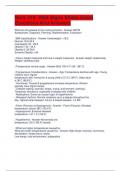Nurs 310- Vital Signs Slides Exam
Questions And Answers
What are the phases of the nursing process - Answer-ADPIE
Assessment, Diagnosis, Planning, Implementation, Evaluation
/.BMI classifications - Answer-Underweight: <18.5
Normal: 18.5-24.9
Overweight: 25 - 29.9
Obesity I: 30 - 34.9
Obesity II: 35-39.9
Extreme Obesity: >40
/.How is height measured and how is weight measured - Answer-Height: stadiometer
Weight: standing scale
/.Temperature normal range - Answer-96.8-100.4° F (36 - 38° C)
/.Temperature Considerations - Answer-- Age: Temperature declines with age. Young
children can't regular
temperature well, normal for a young child is 37.2 C (99 F), Older adult
is 36 C (96.8 F)
- Hormones: Thyroid & progesterone increase temperature. Women
typically have higher temps.
- Lifestyle (eating, exercise, stress, crying, environment, clothing):
Temporary elevations, especially increased with children
- Medications: Some can cause hypo- & hyperthermia
- Biological rhythms: Normal variations up to a degree throughout the
day, highest temp between 4-6 pm & lowest between 1-4 AM
/.Fever (Pyrexia) vs Hyperpyrexia - Answer-- Fever (Pyrexia): Elevated
temperature, above 38C (100.4 F)
• Hyperpyrexia: Extreme elevated
temperature, >41.1 C (106 F)
/.Hypothermia - Answer-Abnormally low
temperature <35 C (95 F) rectally
/.What are higher temperatures caused by
What are lower temperatures caused by - Answer-High temps: exercise, hormones,
dehydration, illness/injury, stress
Low temps: cold environment, antipyretics
, /.Different temperature sites and their expected temps - Answer-- Oral: For alert,
cooperative patients. Adult average 37 C (98.6 F)
- Rectal: For confused, comatose,
uncooperative, unable to close
mouth. Average adult 37.5 C (99.5 F)
- Axillary: Less accurate, average 36.5C (97.5 F)
- Tympanic: Uses infrared sensor to detect temperature, variable
accuracy; 37.5C (99.5F)
- Temporal: Infrared scanner. Weather and activity can
cause alterations; 37.5 C (99.5 F)
/.What are the 2 parts of a pulse - Answer-Heart rate and rhythm
/.Normal adult pulse rate and peripheral pulse sites - Answer-- 60-100 BPM
- temporal, carotid, brachial, radial, femoral, popliteal, posterior tibialis, dorsalis pedis
/.What is the s1 and s2 sounds - Answer-S1: tricuspid and mitral valves closing
S2: Aortic and pulmonary closing
/.What is an apical pulse and how is it found - Answer-- if a pulse is irregular, the apical
pulse is auscultated
- 5th intercostal space left midclavicular line
/.What is a pulse deficit? - Answer-difference between apical and radial pulse
/.What is Bradycardia and its potential causes - Answer-- Rate <60 BPM
- Medications: digoxin, calcium channel blockers (verapamil), beta-blockers
(propranolol)
- long term physical fitness
- chronic, severe pain
- position change from standing to sitting or laying down
- hypothyroidism
- hypothermia
/.What is Tachycardia and its potential causes - Answer-- Rate >100 BPM
- Medications: epinephrine, levothyroxine, beta2 adrenergic agonists (albuterol)
- exercise
- Stress, anxiety, fear
- fever
- acute pain
- position change from laying down to sitting or standing
- hyperthyroidism
- anemia, hypoxemia
- Hypovolemia, shock, heart failure
/.Sinus Arrhythmia - Answer-- pulse rate increases




